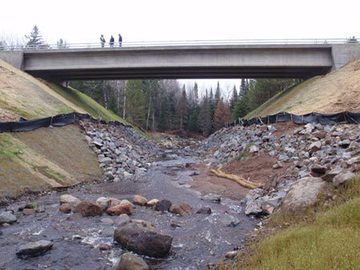September 26, 2014
Innovation Implementation: Construction Manager/General Contractor
The construction manager/general contractor project delivery method is helping highway agencies deliver challenging projects that benefit from early contractor involvement. It uses a two-phase contracting process "design and construction" that enables the project owner to incorporate a contractor's perspective on planning and design decisions.
Highway agencies in seven states have completed demonstration projects using CM/GC, including six that have made it a standard practice. Another nine are working on demonstrations.

CM/GC helped expedite delivery of a new bridge on the Fond du Lac Reservation in Minnesota.
- The Los Angeles Bureau of Engineering in California is using CM/GC on its project to replace the Sixth Street Bridge over the Los Angeles River.
- The Colorado Department of Transportation is developing a new CM/GC manual based on best practices and lessons learned from recent projects. The agency has two CM/GC projects in construction and four in the preconstruction phase.
- The Vermont Agency of Transportation is planning to start construction on its first two CM/GC projects, one in Middlebury and one in Hartford.
Arizona Workshop Explores Bridge Innovation
An accelerated bridge construction workshop in Phoenix, Arizona, focused on geosynthetic reinforced soil integrated bridge system technology. About 85 representatives from the Arizona Department of Transportation, local agencies, consultants and contractors attended the September 10 event. The purpose was to show that GRS-IBS bridges save construction time, are more durable than bridges constructed by traditional methods and are less expensive to build.
States Train First Responder Trainers
State and local agencies in Arkansas collaborated with FHWA on the state's second traffic incident management train-the-trainer session September 16 and 17 in North Little Rock. The session drew 47 representatives of police, fire, emergency medical service, emergency response, highway and towing agencies. In Lincoln, Nebraska, a second offering of the train-the-trainer course trained 33 attendees from local fire, rescue, law enforcement and emergency management agencies, as well as the Nebraska Department of Roads and Nebraska State Patrol.
STIC Incentives Approved for Maine
Two projects supported by the Maine State Transportation Innovation Council have been approved for STIC Incentive funds. A project submitted by Maine's four metropolitan planning organizations received a grant to improve traffic incident location accuracy. The Maine Department of Transportation received funds for a project that will help the agency continue refinement of business processes, technologies and user training to expand the use of 3-D model data for construction.
New Jersey Develops Bog Turtle Agreement
The New Jersey Department of Transportation and FHWA have developed a programmatic biological agreement for the bog turtle, which is on the U.S. Fish and Wildlife Service threatened list. The agreement is designed to provide a streamlined Section 7 process for highway construction and maintenance projects. There's no programmatic coverage for the bog turtle in other states that contain this species, so states can benefit by using the New Jersey agreement as a template.
Oklahoma Uses Bridge Slide Technique
The Oklahoma Department of Transportation is using the slide-in bridge technique on its Cottonwood Creek Bridge project. The new bridge is a two-span prestressed concrete girder with a cast-in-place deck. On September 16 the existing bridge was demolished and the next day the first new span was slid into place. The bridge was moved using a track and a jacking system to pull each span into position. The project requires closing the highway to traffic for about 14 days, compared to up to six months for traditional construction.
Ribbon Cut on Alaska Project
FHWA's Western Federal Lands Highway Division cut the ribbon September 12 on the $41.6 million Deweyville-to-Neck Lake portion of the North Prince of Wales Road design-build project in Alaska. Also on hand were representatives of the Alaska Department of Transportation and Public Facilities, Alaska Department of Fish and Game, U.S. Forest Service and Prince of Wales Island communities. The project purpose was to transform a one-lane logging road into a two-lane paved roadway, build two bridges and install large culvert pipes to enable fish to migrate upstream.
AASHTO Offers NEPA Document Guide
Preparing High-Quality NEPA Documents for Transportation Projects, a new guide from the American Association of State Highway and Transportation Officials, bridges the gap between the theory and practice of producing National Environmental Policy Act documents for projects. The handbook focuses on preparing environmental impact statements and assessments. It covers key issues to consider, a summary of regulations and guidance, practical tips for developing documents and a reference list. Specific techniques are illustrated in a companion report, Examples of Effective Techniques for Improving the Quality of Environmental Documents.


